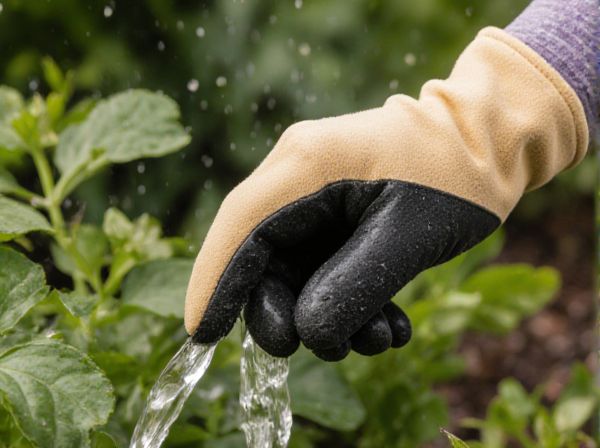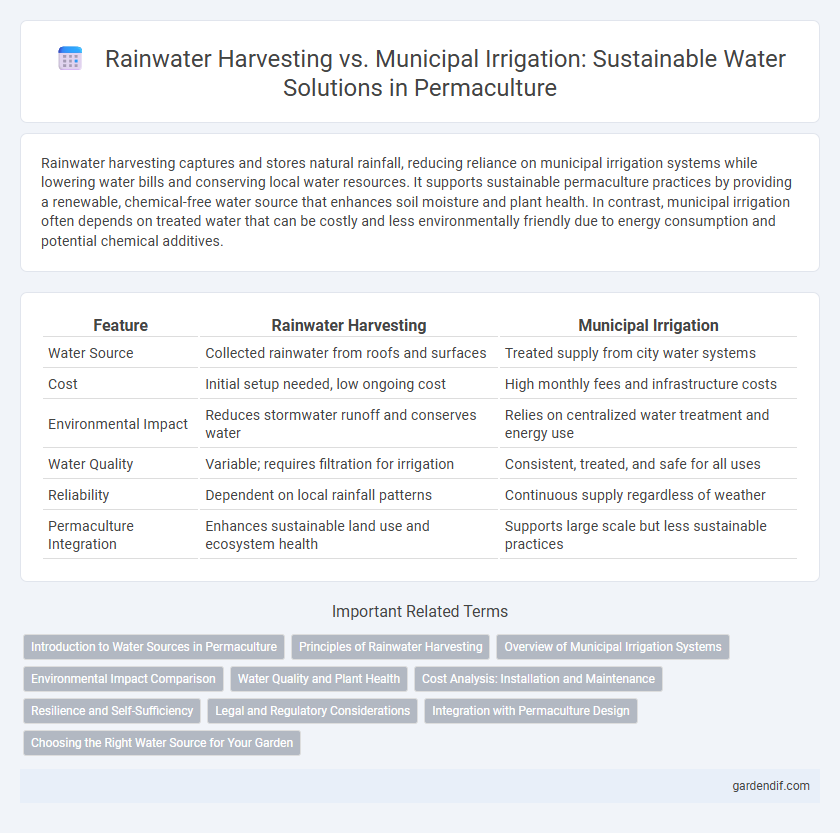
rainwater harvesting vs municipal irrigation Illustration
Rainwater harvesting captures and stores natural rainfall, reducing reliance on municipal irrigation systems while lowering water bills and conserving local water resources. It supports sustainable permaculture practices by providing a renewable, chemical-free water source that enhances soil moisture and plant health. In contrast, municipal irrigation often depends on treated water that can be costly and less environmentally friendly due to energy consumption and potential chemical additives.
Table of Comparison
| Feature | Rainwater Harvesting | Municipal Irrigation |
|---|---|---|
| Water Source | Collected rainwater from roofs and surfaces | Treated supply from city water systems |
| Cost | Initial setup needed, low ongoing cost | High monthly fees and infrastructure costs |
| Environmental Impact | Reduces stormwater runoff and conserves water | Relies on centralized water treatment and energy use |
| Water Quality | Variable; requires filtration for irrigation | Consistent, treated, and safe for all uses |
| Reliability | Dependent on local rainfall patterns | Continuous supply regardless of weather |
| Permaculture Integration | Enhances sustainable land use and ecosystem health | Supports large scale but less sustainable practices |
Introduction to Water Sources in Permaculture
Permaculture emphasizes sustainable water management by prioritizing rainwater harvesting over reliance on municipal irrigation systems. Rainwater collection captures natural precipitation, reducing dependency on treated municipal water and minimizing environmental impact. Utilizing harvested rainwater supports soil health and plant growth while conserving valuable freshwater resources essential for resilient permaculture ecosystems.
Principles of Rainwater Harvesting
Rainwater harvesting captures and stores natural precipitation for sustainable irrigation, reducing dependency on municipal water systems and minimizing environmental impact. Key principles include maximizing catchment efficiency, optimizing storage capacity, and ensuring water quality through filtration and sedimentation methods. Integrating rainwater harvesting into permaculture designs promotes water conservation, cost savings, and ecological balance by utilizing renewable water sources.
Overview of Municipal Irrigation Systems
Municipal irrigation systems rely on centralized water supply networks, typically sourcing water from rivers, lakes, or groundwater treated for urban use. These systems often involve large-scale infrastructure including pumps, pipes, and automated controllers to distribute water efficiently across public landscapes. While municipal irrigation provides consistent water delivery, it can lead to increased energy consumption and water waste compared to decentralized rainwater harvesting methods in permaculture design.
Environmental Impact Comparison
Rainwater harvesting reduces reliance on municipal irrigation systems, significantly lowering energy consumption and greenhouse gas emissions associated with water treatment and distribution. It promotes groundwater recharge and decreases urban runoff, mitigating pollution and erosion in natural waterways. Using harvested rainwater also conserves freshwater resources, enhancing sustainability in permaculture landscapes.
Water Quality and Plant Health
Rainwater harvesting provides nutrient-rich, uncontaminated water that promotes healthier soil microbiomes and enhances plant growth, unlike municipal irrigation which often contains chlorine, fluoride, and salts that can degrade soil quality and hinder plant vitality. Using harvested rainwater minimizes exposure to chemical additives, reduces soil salinization, and supports robust plant root systems by maintaining balanced pH levels and natural microbial activity. Optimal water quality from rainwater harvesting directly correlates with improved plant health, higher yields, and sustainable garden ecosystems.
Cost Analysis: Installation and Maintenance
Rainwater harvesting systems require an initial installation cost typically ranging from $500 to $2,500 depending on the size and complexity, with minimal ongoing maintenance expenses primarily for cleaning and occasional repairs. Municipal irrigation relies on continuous monthly water bills that can accumulate to $1,000 or more annually for large landscapes, alongside maintenance costs for irrigation infrastructure. Over time, rainwater harvesting presents a cost-effective alternative by reducing dependency on municipal water and lowering utility expenses significantly.
Resilience and Self-Sufficiency
Rainwater harvesting enhances resilience by reducing dependency on municipal irrigation systems vulnerable to disruptions and price fluctuations. By capturing and storing rainwater, permaculture designs promote self-sufficiency, enabling consistent water supply for gardens and landscapes during dry spells. This sustainable water management practice supports long-term ecological balance and reduces strain on centralized water infrastructure.
Legal and Regulatory Considerations
Rainwater harvesting systems often face fewer regulatory barriers compared to municipal irrigation, with many regions encouraging on-site water capture through incentives and relaxed permitting. Municipal irrigation typically adheres to strict water usage regulations and metering requirements imposed by local authorities to ensure sustainable supply and prevent overuse. Legal frameworks increasingly favor decentralized water management, promoting rainwater harvesting as a compliant and eco-friendly alternative in permaculture design.
Integration with Permaculture Design
Rainwater harvesting aligns seamlessly with permaculture design by enhancing on-site water retention and reducing dependency on municipal irrigation systems, thus fostering sustainable water cycles within the ecosystem. It supports soil health by providing chemical-free, nutrient-rich water directly to plants, unlike municipal irrigation which often relies on treated water that may contain additives harmful to soil microorganisms. Integrating rainwater collection into permaculture not only conserves water but also encourages a regenerative landscape that mimics natural hydrological processes, promoting long-term resilience and productivity.
Choosing the Right Water Source for Your Garden
Selecting the appropriate water source for your garden hinges on factors such as sustainability, cost, and availability. Rainwater harvesting captures natural precipitation, reducing dependency on municipal systems and lowering water bills while promoting eco-friendly gardening practices. Municipal irrigation offers convenience and consistent supply but often involves higher costs and environmental impacts due to treatment and distribution processes.
rainwater harvesting vs municipal irrigation Infographic

 gardendif.com
gardendif.com